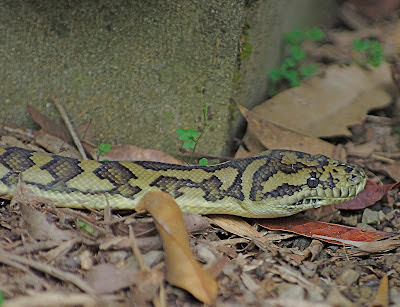An Unexpected Visitor
The other day an unexpected visitor appeared on the ground in mid afternoon. It is Morelia spilota, one of the six subspecies or races of the Carpet Python. Now which one is the one in the garden. Well is could be the Jungle Carpet Python, M. s. cheynei or the Coastal Carpet Python, M. s. mcdowelli.
This one seems to have characters of both subspecies or races. This is probably because this individual is hybrid between the two. But since they are the same species, they share the same genetics. If the two races overlap, then a blending of characteristics should result in the offspring. In any case, this fellow appeared in the daylight and was very unexpected. I almost stepped right on the poor thing.
It checked out this small tree and eventually came to ground and disappeared into the bush. This python is fond of taking up residence in attics and rooftops. It feeds on mice, various mammals and birds. Sometimes pets are taken and if the pet was wearing a flea collar, the snake could be in trouble and die from the expericens
And that's the end of the tail (tale) of the Python. Moral: Always watch where you step in the rainforest.
One of the locals who watched the entire proceedings But he had no worries. The python would not be interested in this Boyd's Forest Dragon.
Thanks to both Michael Cermak and Alan Henderson for comments and icentifications.



























